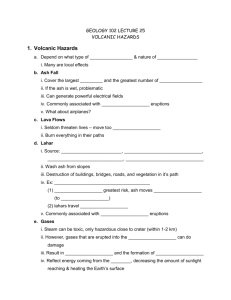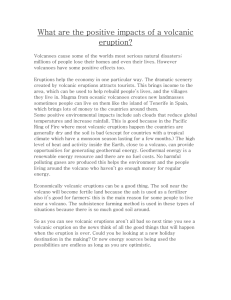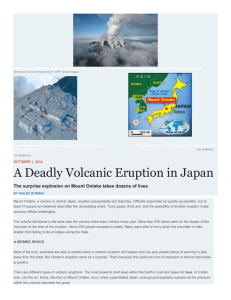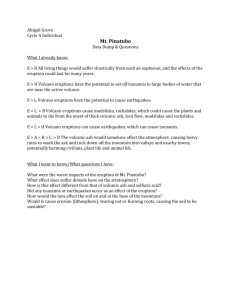Activity 4 Volcanic Hazards: Airborne Debris
advertisement
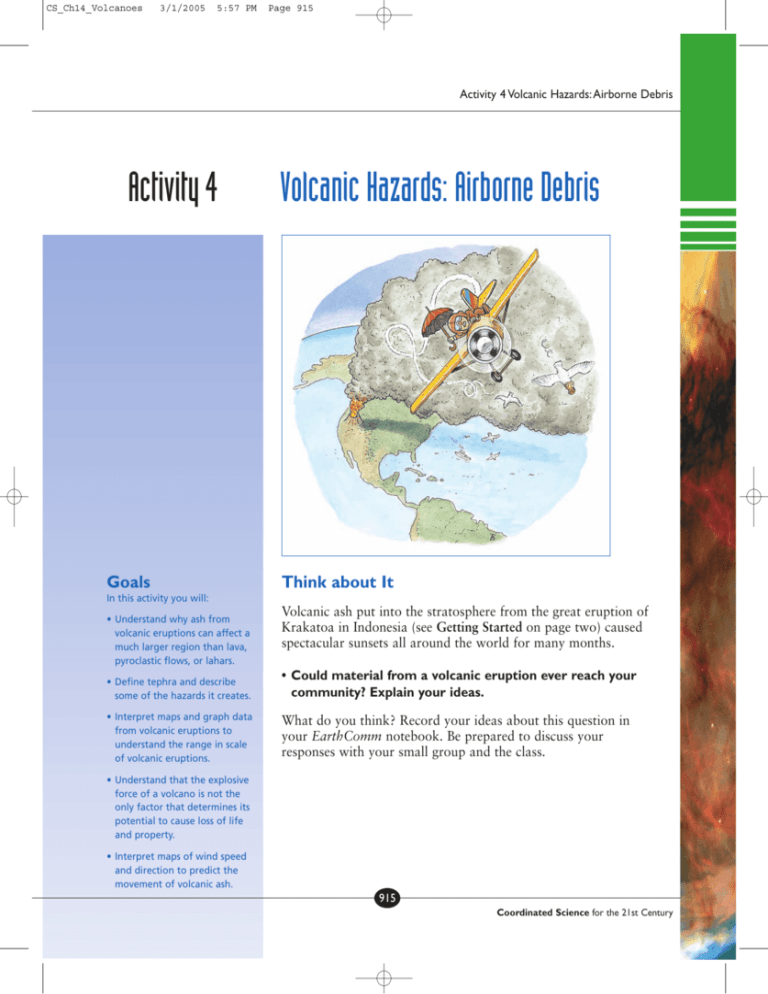
CS_Ch14_Volcanoes 3/1/2005 5:57 PM Page 915 Activity 4 Volcanic Hazards: Airborne Debris Activity 4 Goals Volcanic Hazards: Airborne Debris Think about It In this activity you will: • Understand why ash from volcanic eruptions can affect a much larger region than lava, pyroclastic flows, or lahars. Volcanic ash put into the stratosphere from the great eruption of Krakatoa in Indonesia (see Getting Started on page two) caused spectacular sunsets all around the world for many months. • Define tephra and describe some of the hazards it creates. • Could material from a volcanic eruption ever reach your community? Explain your ideas. • Interpret maps and graph data from volcanic eruptions to understand the range in scale of volcanic eruptions. What do you think? Record your ideas about this question in your EarthComm notebook. Be prepared to discuss your responses with your small group and the class. • Understand that the explosive force of a volcano is not the only factor that determines its potential to cause loss of life and property. • Interpret maps of wind speed and direction to predict the movement of volcanic ash. 915 Coordinated Science for the 21st Century CS_Ch14_Volcanoes 3/1/2005 5:57 PM Page 916 Volcanoes Investigate a) How many states showed at least a trace of volcanic ash? 1. Look at the map of the 1980 eruption of Mt. St. Helens. It shows the pattern of ash. Use the map to answer the following questions: b) In what direction did the ash move? c) Was Canada affected by ash from Mt. St. Helens? Why or why not? Spokane Ritzville Mount St. Helens d) Would you consider this a small, medium, large, or gigantic eruption? Explain your choice. Yakima 2. Make a bar graph of the data shown in the table. a) Plot the name of each volcano on the horizontal axis. 2 to 5 inches 1/2 to 2 inches Trace to 1/2 inch b) Plot the volume of volcanic eruption on the vertical axis. Arrange the volumes in order from least to greatest. Mount St. Helens' May 18, 1980 ash fallout distribution within the U.S. Distribution of ash from Mt. St. Helens eruption. Volumes of Volcanic Eruptions Volcano Date Ilopango, El Salvador 300 40 Krakatoa, Indonesia 1883–84 Long Valley, California (Bishop Tuff) 740,000 years ago Mazama, Oregon 4000 B.C . Mt. Pelée, Martinique 1902 0.5 Mt. St. Helens, Washington 1980 1.25 Nevado del Ruiz, Colombia 1985 0.025 Pinatubo, Philippines 1991 10 Santorini, Greece 1450 B.C . 60 Tambora, Indonesia 1815 150 Valles, New Mexico 1.4 million years ago 300 Vesuvius, Italy 79 Yellowstone, Wyoming (Lava Creek Ash) 600,000 years ago 2.4 500 75 3 Note:Volumes are approximate. 916 EarthComm Volume (cubic kilometers) 1000 CS_Ch14_Volcanoes 3/1/2005 5:57 PM Page 917 Activity 4 Volcanic Hazards: Airborne Debris 4. The following map shows the areas covered by five of the eruptions in the data table. Use the map, data table, and your bar graph to do the following: 3. Use your graph and the table to answer the following questions. Record your answers in your notebook. a) Can you group the eruptions by size (small, medium, and so on)? Mark the groups on your plot. Explain how you chose the groups. a) Rank the area of eruptions in order from smallest to largest. Record your rankings. b) Compare the areas to the volumes. Describe any relationships. b) What group does the 1980 eruption of Mt. St. Helens fit into? c) Compare the location of each volcano to the path of the ash. Describe any patterns. What might explain any patterns you see? c) Suppose you wanted to predict the area that would be covered with ash by each eruption. What other information (besides volume erupted) would help you to predict how far the ash would go? Mazama ash Mount St. Helens Mount St. Hel en sa sh Yellowstone e rr y Bishop tuff ( ro m f (f tuf l lo Ye w on from Lo n alley) gV ge Rid Long Valley st Ye llo e) ton ws H u ck l e b Mt. Mazama (Crater Lake) Lava Cre ek tu ff (f rom e) Reflecting on the Activity and the Challenge your ideas about the areas that can be affected by an erupting volcano? Be sure to include the effect of airborne volcanic hazards into your story line. This activity gave you a chance to explore factors that affect the movement of volcanic ash. How did this change 917 Coordinated Science for the 21st Century CS_Ch14_Volcanoes 3/1/2005 5:57 PM Page 918 Volcanoes Digging Deeper Geo Words AIRBORNE RELEASES tephra: a collective term for all the particles ejected from a volcano and transported through the air. It includes volcanic dust, ash, cinders, lapilli, scoria, pumice, bombs, and blocks. volcanic bomb: a blob of lava that was ejected while viscous and received a rounded shape (larger than 64 mm in diameter) while in flight. lapilli: pyroclastics in the general size range of 2 to 64 mm. ash: fine pyroclastic material (less than 2 mm in diameter). Particle Types Tephra is a term for pieces of volcanic rock and lava that are ejected into the air. It ranges from less than 0.1 mm to more than one meter in diameter. Tephra is classified by size. Names for sizes of tephra include volcanic bombs (greater than 64 mm), lapilli (between 2 and 64 mm), and ash (less than 2 mm). Bombs and lapilli usually fall to the ground on or near the volcano. Ash can travel hundreds to thousands of kilometers. (See Figure 1.) The height of the ash and the wind speed control how far the ash travels. Distribution A volcanic eruption can send ash many kilometers into the atmosphere.Ash from the 1980 eruption of Mt. St. Helens reached a height of 19 km.Winds carried the ash to the east. Five days after the eruption, instruments in New England detected ash.An eruption at Yellowstone 2 million years ago produced 1000 times as much ash.An area of 1000 km2 received one meter of ash.Ten centimeters of ash covered an area of 10,000 km2.You could look at it this way: if the ash from Mt. St. Helens filled a shoe box, the ash from Yellowstone would fill a bedroom to a depth of a meter! prevailing wind tephra fall tephra deposit Figure 1 Ballistic debris refers to volcanic bombs and lapilli that fall on or near the volcano. Ash can travel much further. Hazards of Volcanic Ash Volcanic ash presents many kinds of hazards. Ash that falls on homes, factories, and schools can collapse roofs. More than 300 people died after tephra plume the 1991 eruption of Mt. Pinatubo in the Philippines. Most of these deaths were caused by eruption roof collapse. At ground level, fine ash causes column ballistic breathing problems in humans and animals. It can debris also damage automobile and truck engines. Ash that coats the leaves of plants interferes with photosynthesis. Ash injected higher into the atmosphere can damage aircraft. In the last 15 years, 80 commercial aircraft have been damaged as they flew through volcanic ash.The only death outside the immediate area of Mt. St. Helens occurred from the crash of a small plane that was flying through the ash. Ash that falls on the slopes of a volcano poses great risk.When soaked by rain, loose ash can form lahars. Years after the eruption, lahars remain a source of concern to communities at the base of Mt. Pinatubo. 918 EarthComm CS_Ch14_Volcanoes 3/1/2005 5:57 PM Page 919 Activity 4 Volcanic Hazards: Airborne Debris Figure 2 Volcanic ash landing on buildings can result in death.Volcanic ash is also a hazard to airplanes on the ground as well as in the air. Geo Words Volcanic Explosivity Index The table in Figure 3 is a scale of eruption magnitude.The scale is known as Volcanic Explosivity Index, or VEI.The VEI is based on the volume of erupted material and the height it reaches.The size of an eruption depends upon several factors.Two important factors are the composition of the magma and the amount of gas dissolved in the magma.The viscosity of a magma depends on two things: the temperature of the magma, and its chemical composition.The higher the silica content of magma, the more viscous it is.The more viscous it is, the more likely it is for gas pressure to build. High-silica volcanoes, like Yellowstone, erupt extremely violently, but on a scale of tens or hundreds of thousands of years.Volcanoes with intermediate silica contents, like Mt. St. Helens, commonly produce violent eruptions with a frequency of hundreds or thousands of years. Silica-poor magmas, like those erupted at Kilauea, feed less explosive eruptions that occur more often. Volcanic Explosivity Index: the percentage of pyroclastics among the total products of a volcanic eruption. Volcanic Explosivity Index (VEI) VEI 0 1 2 3 4 5 6 7 Plume Height <100 m 100–1000 m 1–5 km 3–15 km 10–25 km >25 km >25 km >25 km Volume How often 1000’s m3 10,000’s m3 1,000,000’s m3 10,000,000’s m3 100,000,000’s 1 km3 10’s km3 100’s km3 m3 Example Daily Kilauea Daily Stromboli Weekly Galeras, 1992 Yearly Ruiz, 1985 10’s of years Galunggung, 1982 100’s of years St. Helens, 1980 100’s of years Krakatoa, 1883 1000’s of years Tambora, 1815 Figure 3 919 Coordinated Science for the 21st Century CS_Ch14_Volcanoes 3/1/2005 5:57 PM Page 920 Volcanoes Check Your Understanding 1. Review any words from the Digging Deeper sections of the previous activities that are used in this section but may still be unfamiliar to you. Briefly explain the meaning of each of the following terms: lahar, pyroclastic flow, caldera. It might seem that the number of deaths caused by an eruption should always increase as the VEI increases.The table of VEI and deadliest eruptions in Figure 4 shows that this is not the case. For example, mudflows after the 1985 eruption of Nevado del Ruiz (Colombia) killed more than 25,000 people.This was the worst volcanic disaster since Mount Pelée in 1902. However, both eruptions had a VEI below five. Of the seven most deadly eruptions since 1500 A.D., only Tambora and Krakatoa erupted with greater explosive force (VEI above 5). Volcanic Explosivity Index (VEI) of the Deadliest Eruptions since 1500 A.D. Eruption Year VEI Casualties Nevado del Ruiz, Colombia 1985 3 25,000 2. In your own words explain the meaning of tephra and how volcanic bombs, lapilli, and ash relate to tephra. Mount Pelée, Martinique 1902 4 30,000 Krakatoa, Indonesia 1883 6 36,000 Tambora, Indonesia 1815 7 92,000 Unzen, Japan 1792 3 15,000 3. Name two factors that can affect the distance that volcanic ash can travel. Lakagigar (Laki), Iceland 1783 4 9000 Kelut, Indonesia 1586 4 10,000 4. How does the silica content of magma affect how explosive a volcano can be? 5. a) What does VEI represent? b) Is VEI on its own a good indicator of the dangers involved with a volcanic eruption? Explain your answer. Figure 4 Tambora erupted in 1815. It had a VEI of 7. Pyroclastic flows streamed down its slopes. Ash rose 44 km. About 150 km3 of ash were erupted (about 150 times more than the 1980 eruption of Mt. St. Helens). A caldera formed when the surface collapsed into the emptying magma chamber.The Tambora caldera is 6 km wide and 1.1 km deep.Tephra fall, a tsunami (a giant sea wave caused by the explosion), and pyroclastic flows killed about 10,000 people. More than 82,000 people died from famine. It is thought that the ash shortened the growing season. 920 EarthComm CS_Ch14_Volcanoes 3/1/2005 5:58 PM Page 921 Activity 4 Volcanic Hazards: Airborne Debris Understanding and Applying What You Have Learned 1. In your own words, compare the sizes of the areas affected by lava, pyroclastic flows, and ash falls. one of your three volcanoes on the Internet. Simulate the eruption of one of your three volcanoes. 2. Is volcanic ash a concern only in the western United States? Explain your answer. a) Print out and describe the paths of the ash from the simulation. 3. Why do eruptions in Hawaii differ from the Mt. St. Helens eruption? b) What do the maps tell you about the prevailing wind directions for your community? 4. Look at your list of the three volcanoes that are closest to your community. Go to the AGI EarthComm web site to find out how to simulate the eruption of c) Do the prevailing wind directions change seasonally in your area? If yes, how would this affect the pattern of ash fallout? Preparing for the Chapter Challenge affected by the eruption? Think about how your study of the movement and hazards of volcanic ash has changed your ideas. Be sure to include this information in your story. In Activity 1 you were asked to describe to your audience the place that you thought a volcanic eruption was most likely to occur. Did you leave the impression in your story that this was the only area to be Inquiring Further Devise a method to outline the distribution of material when there is no wind, weak wind, and strong wind. Compare how far the sand travels and how far the baby powder travels. Consider the factors of particle size, wind speeds, wind direction, and topography. As part of your Chapter Challenge you may wish to include a presentation and explanation of your model. 1. Make a model of tephra transport Build a model of a volcano that has exploded (Mt. St. Helens). Run a tube up through the vent of the volcano. Mix a small amount of baby powder with some sand. Use a funnel to pour the sand mixture down the other end of the tube. Attach a bicycle pump to pump the sand out of the volcano. Use a fan or hair dryer to simulate winds. Use eyewear whenever non-water liquids and/or particles such as sand are used. If this activity is done indoors use a large, clear area. Clean the area well when you are done. Sand on the floor can be slick. 921 Coordinated Science for the 21st Century



